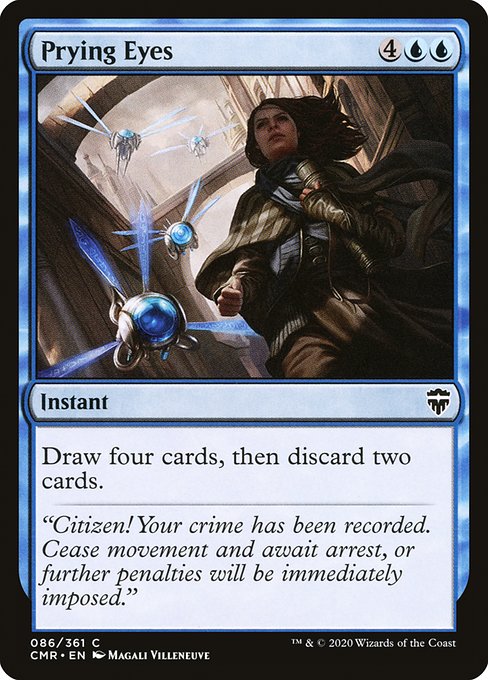
Image courtesy of Scryfall.com
Prying Eyes: How Global Cultures Shape MTG Artwork
Blue mana often feels like a compass for curious minds in Magic: The Gathering, guiding players toward information, tempo, and cunning. When you look at a card like Prying Eyes, you’re not just seeing a spell you can cast; you’re witnessing a chorus of cultural echoes stitched into the artwork and the very mechanics. This particular instant, with a cost of four generic and two blue mana (4UU) and a potent draw/discard engine, embodies blue’s love of mind games, perpetual motion, and the elegance of a well-timed gambit. The piece, illustrated by Magali Villeneuve and set in Commander Legends, invites you to read the world in its lines as much as you read it in its text 🧙♂️🔥.
Ask any blue mage about drawing and you’ll hear a familiar refrain: information is power. Prying Eyes delivers four cards to your hand, then asks you to discard two, a neat two-step that rewards deliberate engine-building. The card’s rarity—common, yet foil and nonfoil finishes available—speaks to Commander Legends’ mission: give players robust tools without forcing rare-card scarcity into every interaction. The flavor text—“Citizen! Your crime has been recorded. Cease movement and await arrest, or further penalties will be immediately imposed.”—casts a bureaucratic glow across the frame. It’s not just about “draw more,” it’s about how knowledge can be policed, channeled, or weaponized, depending on the table’s mood ⚔️🎨.
Flavor whisper: Citizen! Your crime has been recorded. Cease movement and await arrest, or further penalties will be immediately imposed.
A Window into Blue’s Eye-Patterned Aesthetics
The artwork fuses a crisp line vocabulary with a cool palette—blues and teals that conjure water, glass, and reflection. That visual emphasis mirrors blue’s ethos: perception, synthesis, and a kind of cool, collected control. The eye motif—literal and metaphorical—echoes across cultures. In many traditions, the eye is both a beacon and a surveillance symbol, a motif that appears in everything from ancient Persian and Ottoman tile work to East Asian ink brush painting. Villeneuve’s composition leverages these cross-cultural cues to create a sense of distant, rational order watching over a chaotic, information-rich landscape 🧙♂️💎.
Global artistry in MTG isn’t about literal translation of a culture onto card borders; it’s about a conversation. You’ll notice the angular architecture and tessellated textures that could sit comfortably in a Moorish courtyard, a Nordic hall, or a Japanese screen. The result is a polyglot aesthetics that resonates with players who come from all over the world, each seeing a familiar pattern in the card’s geometry and the way the spell bends time and choice. It’s a reminder that the multiverse is a tapestry, with threads pulled from many corners of the globe 🎲🔥.
Gameplay and Design: Strategy Woven into Mythic Threads
Prying Eyes slots neatly into blue’s tradition of card advantage and tempo. In multiplayer formats—Commander, of course—the draw-discard dynamic can empower you to refresh your hand while trimming opponents’ options. The 6-mana investment might seem steep, but in the right table state, casting this instant can unlock four fresh cards while setting up a future hand disruption plan. The card also fits neatly with wheel effects and self-mend strategies—blue’s perennial method for turning a potential disadvantage (to draw too many cards) into a controlled advantage. The physical card, printed in Commander Legends, leans into the set’s broader design ethos: value given through shared, interactive play rather than static beatdown 🔥⚔️.
Collectors and players alike appreciate how the art and mechanics reinforce one another. The flavor text’s bureaucratic menace pairs with the instant-speed inevitability of a well-timed draw spell, inviting players to consider not just what their hands contain but who’s watching what’s in those hands. In a game that often hinges on information, Prying Eyes feels like a microcosm of the MTG universe—beauty and danger, knowledge and consequence, all at the speed of a spell resolve 🧙♂️🎨.
Collectibility, Value, and the Culture of Art
As a common card from Commander Legends, Prying Eyes sits at a price point that makes it accessible to many players who want to curate a blue-centric draw engine for EDH or casual one-on-one. Foil versions carry a premium, the kind that true collectors chase for their ability to capture light and color from Villeneuve’s crisp linework. Beyond pricing, the card contributes to a larger cultural conversation: MTG art has grown into a global gallery where style and symbolism mingle across borders. The artwork’s restraint and clarity also make it a favorite for people who love to frame their favorites—art in a deck box is art that travels with you to every table—shouting with the same quiet, strategic confidence as blue itself 💎🎲.
Whether you’re a long-time commander enthusiast or a newer player curious about how culture informs craft, Prying Eyes invites you to look closer at the world behind the spell. Look at the composition, the negative space, the way light catches on the eyes in the foreground. There are stories layered into the canvas, just waiting for someone to discover them between draws and discards 🧙♂️.
To those who want to blend the elegance of global-inspired art with the thrill of clever gameplay, this card is a reminder: magic is a universal language, spoken in colors, lines, and the language of strategy. And the next time you cast it, you’ll know you’re not just drawing cards—you’re reading a mosaic of cultures stitched into a single moment of play 🔮💎.
Custom Neon Gaming Mouse Pad 9x7 Neoprene with Stitched EdgesMore from our network
- https://transparent-paper.shop/blog/post/a-distant-blue-giant-in-the-billion-star-catalog-tale/
- https://blog.crypto-articles.xyz/blog/post/how-to-fix-rollercoaster-tycoon-classic-startup-crashes/
- https://blog.crypto-articles.xyz/blog/post/pokemon-tcg-cosplay-deck-builds-inspired-by-team-aquas-secret-base/
- https://blog.digital-vault.xyz/blog/post/jokulhaups-and-the-rise-of-mtg-joke-cards/
- https://transparent-paper.shop/blog/post/how-to-add-realistic-creases-to-digital-paper/